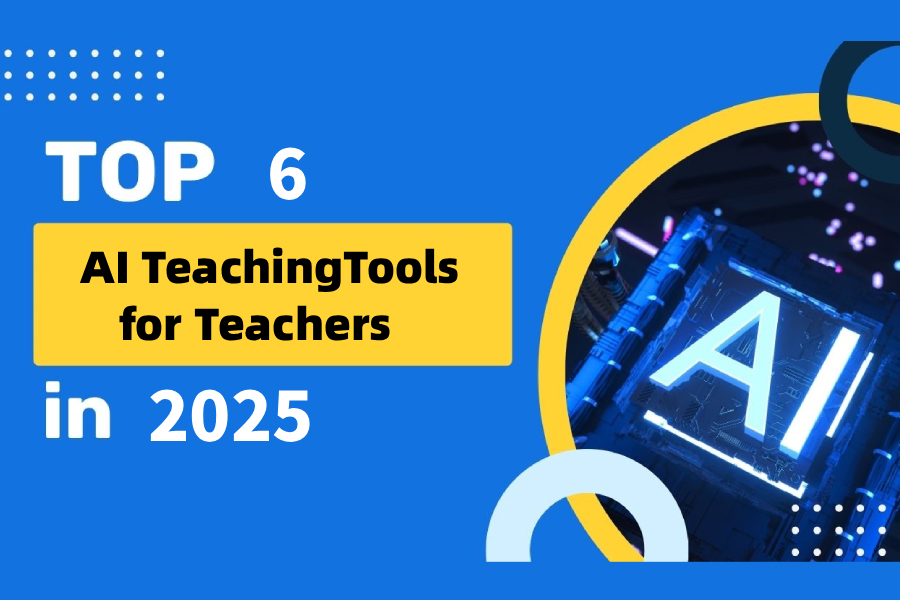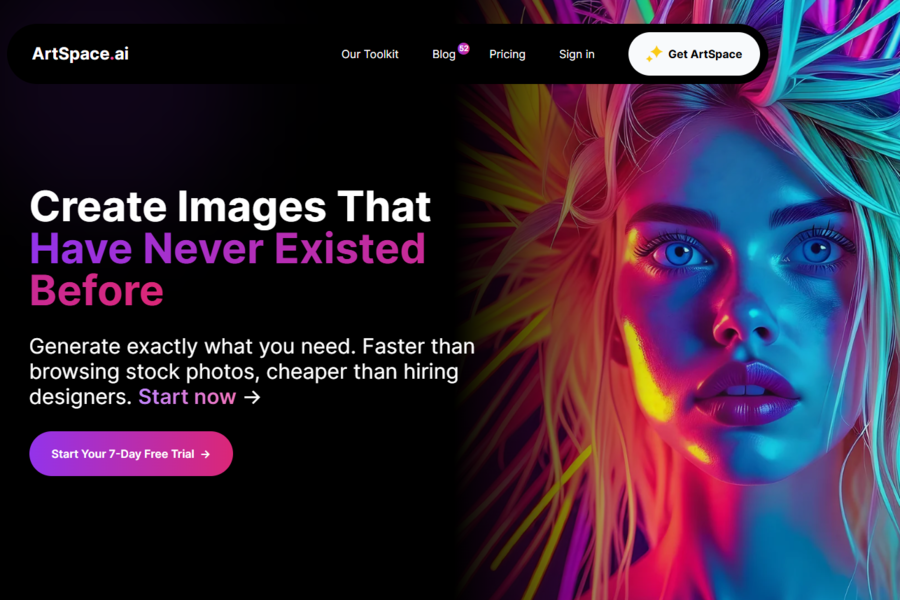In today’s rapidly evolving educational landscape, AI teaching tools for teachers are revolutionizing how educators plan, teach, and assess student learning. These innovative platforms leverage artificial intelligence to save valuable time, enhance instructional quality, and support differentiated learning—enabling teachers to focus more on what truly matters: their students. AGIYes will delve into six top-tier AI education tools—MagicSchool.ai, ClassPoint AI, Diffit, Gradescope, Khanmigo, and Canva Magic Write,to see how they each excel at addressing key pain points in teaching and helping educators build a more efficient, personalized, and creative classroom of the future.
I. Introduction to 6 AI Teaching Tools for Teachers
1. MagicSchool.ai
MagicSchool.ai is a comprehensive AI assistant platform designed specifically for educators. It has over 60 built-in tools aimed at helping teachers with almost every task before, during, and after a lesson, including generating lesson plans, creating differentiated learning materials, drafting emails to parents and students, writing formative and summative assessment questions, drafting individualized education plans (IEPs), and generating instructional stories. Its core goal is to be a teacher’s AI co-pilot, significantly saving time on lesson preparation and administrative tasks.
Pros:
- Comprehensive and Powerful Features: It has an extremely wide range of functions, from generating instructional content to administrative communication, making it a true “one-stop” solution.
- Highly Specialized: The tools are designed to deeply align with a teacher’s actual workflow, such as the “5E Model Lesson Plan Generator” and “Academic Sentence Starter Generator,” which are highly practical.
- Promotes Educational Equity: Features like the “Differentiated Generator” can quickly adapt the same material for students at different reading levels, making personalized teaching easy to achieve.
- Responsible Educational AI: It has a built-in “AI Detector” and “Cite Sources” tool to teach students how to use AI correctly, aligning with educational ethics.
Cons:
- Requires a Learning Curve: Because there are so many features, new users may need some time to explore and familiarize themselves with the best use cases for all the tools.
- Limited Content Depth: As a generative AI, its output can sometimes be superficial and requires teachers to review, deepen, and refine it with their professional knowledge and experience.
Price:
- A free version is available, but with limited features and usage.
- The Plus paid version is $99.96/year, which unlocks unlimited use, longer output, and more advanced features.
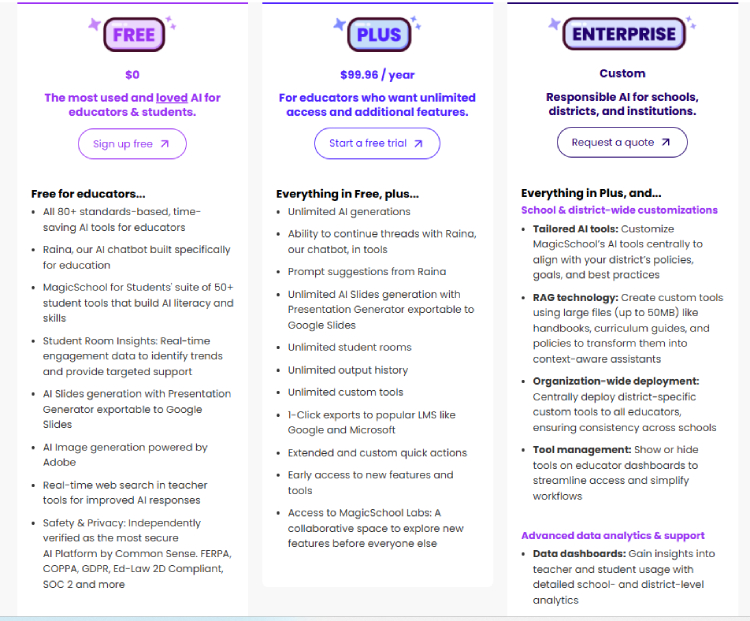
MagicSchool.ai is a powerful, all-purpose assistant for teachers. Not only does it significantly boost work efficiency, but its tools, which are deeply optimized for educational settings, also help teachers implement more advanced and equitable teaching philosophies, making it a top choice for those exploring AI in education.
2. ClassPoint AI
ClassPoint AI is an AI plugin directly embedded in Microsoft PowerPoint. Its core function is to automatically generate various types of interactive quiz questions (such as multiple choice, short answer, fill-in-the-blanks, word clouds, etc.) with a single click based on the content of the current slide (whether text or images). These questions are then directly inserted into the slides, enabling seamless classroom interaction that “asks questions as you go.”
Pros:
- Seamless Integration, Smooth Workflow: It operates directly within the PowerPoint interface, eliminating the need to switch between different software, which greatly enhances the continuity of the teaching process.
- Instant Interaction, Increased Engagement: It can instantly transform static knowledge slides into dynamic, interactive quizzes, effectively capturing student attention and increasing classroom participation.
- Extremely Easy to Use: It requires almost no learning; you just click a button to generate questions, which significantly lowers the technical barrier to entry.
Cons:
- Relatively Singular Functionality: Its main function is focused on generating instant interactive quizzes for the classroom and does not support other stages like lesson preparation or grading.
- Dependent on Specific Software: It can only run in a Microsoft PowerPoint environment, which limits its use cases.
Price:
- Free: Basic functions are available, but with limited generation次数 (times) and types of questions.
- Pro: Around SGD 8/month, which includes all ClassPoint interactive features and unlimited AI question generation.
- Premium Version: Has more features; specific pricing requires contacting Sales.

ClassPoint AI is a “light cavalry” for enhancing classroom interaction. It’s perfect for instructors and teachers who want to make their classes more engaging and interactive quickly and conveniently without changing their existing PowerPoint habits.
3. Diffit
Diffit is an AI tool focused on “differentiation.” A teacher only needs to provide a topic, a piece of text, a video link, or even a website URL, and Diffit can automatically generate a complete teaching resource pack with an adjustable reading level. This pack includes a summary of the original text, a rewritten version for different Lexile levels, a list of keywords, and multiple-choice and short-answer questions.
Pros:
- Differentiation Expert: It excels at adjusting text reading difficulty, making it a “miracle tool” for solving the problem of varying student reading levels in a classroom.
- Extremely Efficient: It shortens the time it takes for a teacher to manually find and adapt materials from hours to just dozens of seconds, saving a significant amount of time.
- Practical Output: It provides a complete resource pack (“Original Text – Rewritten Text – Vocabulary – Questions”) that can be downloaded and used directly for teaching.
- Supports Multiple Languages: It is very friendly to language teachers and foreign language learners.
Cons:
- Specific and Focused Functionality: Its core strength is the differentiated generation of reading materials, unlike all-in-one tools that have a wider scope.
- Content Depth: The generated content is more focused on popularizing background knowledge and basic comprehension. For content that requires deep analysis and critical thinking, teachers still need to supplement it.
Price:
- Free Version: Has usage limits.
Diffit is a precise tool for implementing the philosophy of “teaching to the student’s aptitude.” It perfectly solves the classic teaching problem of “how to get all students to access and understand the same core concept” and is especially suitable for teachers in English, social sciences, and science.
4. Gradescope
Gradescope is an online platform focused on grading and assessing assignments and exams. It supports submissions in various formats, including paper-based assignments, online assignments, and programming projects. Teachers can create detailed grading rubrics on the platform and use AI and machine learning to grade in batches, analyze class-wide and individual student learning data, and generate in-depth assessment reports. This transforms the grading process from a tedious task into a data-driven teaching insight.
Pros:
- Dramatically Increases Grading Efficiency: It allows for instant grading of fixed-answer questions. For subjective questions, once the grading rubric is set, it enables efficient and consistent batch grading.
- Powerful Data Analysis: It provides detailed assessment reports that visually show class weak points, question difficulty analysis, and each student’s growth trajectory.
- Ensures Fair Grading: It supports anonymous grading and rubric-based grading, effectively reducing subjective bias.
- Clear and Transparent Feedback: Students can clearly see where they earned and lost points, which helps them identify gaps in their knowledge.
Cons:
- Complex Initial Setup: It requires a significant time investment upfront to create assignments and set up grading rubrics.
- Not a Content Generation Tool: Its core function is assessment and management; it is not used to create instructional content.
- High Cost for Individual Use: Although most schools purchase it, the subscription cost for individual teachers can be relatively high.
Price:
- Gradescope Basic: Free (offers limited features, suitable for trial or basic needs).
- Gradescope Institutional: Pricing requires contacting Gradescope directly (typically via a feedback form or sales team). Costs are customized based on institution size and needs, with specific amounts not publicly disclosed.

Gradescope is the industry standard for grading and assessment in universities and large courses. Its core value is freeing teachers from burdensome, repetitive grading work and helping to improve instruction through data-driven insights, making it the go-to professional tool for the assessment stage.
5. Khanmigo
Khanmigo is an AI assistant developed by the well-known educational non-profit organization Khan Academy. It is designed to be a tireless, personalized student tutor and a lesson preparation assistant for teachers. Its greatest feature is its Socratic dialogue approach, which encourages students to show their thinking process and find the answer themselves through step-by-step questioning and guidance, instead of being given the direct result. It can also provide teachers with lesson plan suggestions and insights into class learning progress.
Pros:
- Advanced Pedagogical Philosophy: The “guide, don’t give” model aims to cultivate students’ critical thinking and problem-solving abilities, not rote memorization.
- Safe Learning Environment: The dialogue is monitored to ensure safe use in an educational setting, preventing cheating and misuse.
- Deep Content Integration: It is tightly integrated with Khan Academy’s vast course library, so the tutoring content is high-quality and systematic.
- Dual-Perspective Design: It serves both students (as a tutor) and teachers (as a teaching assistant), forming a complete teaching loop.
Cons:
- Access is Somewhat Restricted: It is currently mainly being promoted in the US and may require a waitlist or specific conditions.
- Requires a Paid Subscription: Khan Academy’s content itself is free, but using the Khanmigo features requires a monthly fee.
- Content Scope: Its knowledge system is deeply tied to Khan Academy’s curriculum, so its coverage might be slightly limited in breadth.
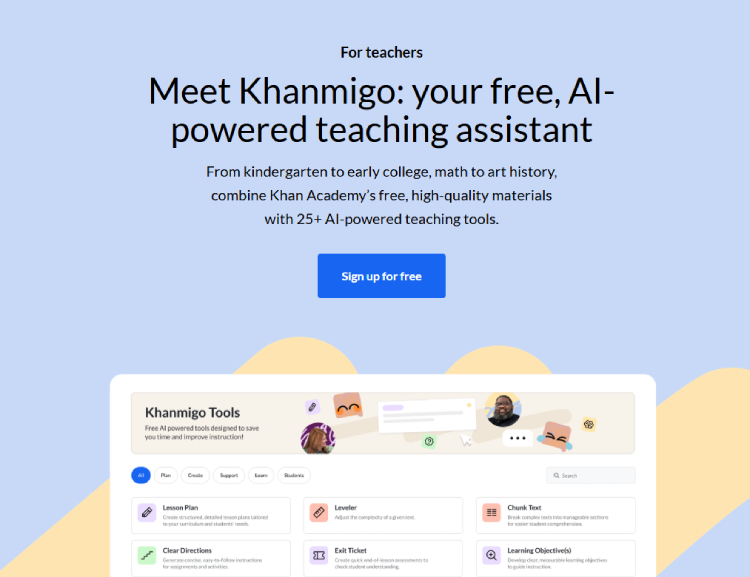
Khanmigo is more than just a tool; it is an AI tutor that embodies an advanced pedagogical philosophy. It is very suitable as a supplemental tool for students’ after-school tutoring and for teachers implementing personalized instruction. It is one of the “ideal models” for the application of AI in education.
6. Canva Magic Write & Magic Design
Magic Write and Magic Design are AI feature suites integrated into Canva, the world’s leading online design platform. Magic Write is a text generation assistant that helps users draft content outlines, emails, creative stories, lists, and other text content. Magic Design is its core visual AI function, where users simply upload an image or input a simple creative idea, and the AI automatically generates beautiful design templates in various styles, such as presentations, posters, social media images, and worksheets.
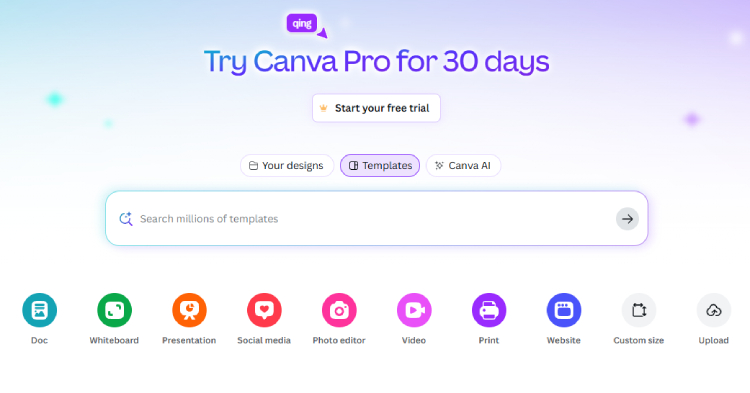
Pros:
- Unbeatable Visualization Capability: It can instantly generate professional and aesthetically pleasing visual materials, which is a huge advantage that pure text-based AI tools cannot match.
- Powerful Creative Inspiration: It is an excellent tool for brainstorming, finding design inspiration, and generating content ideas.
- Seamless Workflow: For Canva’s massive user base, the AI features integrate perfectly with existing design tools, boosting creation efficiency exponentially.
- Extremely Low Barrier to Entry: The operation is intuitive; you just need to drag and drop or enter a prompt, and no design background is required.
Cons:
- General-Purpose Tool: It is not deeply customized for education, so the generated education-related content needs more educational and pedagogical adjustments from the teacher.
- General Text Depth: The text generation ability of Magic Write is relatively basic compared to specialized writing AIs (like ChatGPT) or educational AIs (like MagicSchool).
- Advanced Features Require Payment: Many high-quality AI-generated templates and unlimited use require a Canva Pro subscription.
Price:
- Free Version: Allows basic functions, but the number of generations and available templates are limited.
Canva’s AI features are a “productivity revolution” for visual creation in teaching. They allow every teacher to easily become a designer, quickly producing high-quality, eye-catching presentations, posters, and worksheets for students. This greatly enhances the visual presentation and professionalism of teaching materials and is the “aesthetic leader” that empowers all teaching stages.
II. Conclusion
Integrating AI teaching tools for teachers into daily practice is no longer a futuristic concept—it’s a practical way to enhance educational outcomes and teacher well-being. From all-in-one assistants like MagicSchool.ai to specialized tools such as Diffit and ClassPoint AI, these platforms offer something for every educator looking to innovate, differentiate, and inspire. Whether you’re aiming to reduce administrative burdens, create more inclusive lessons, or foster critical thinking, the right AI tool can help you achieve your goals. Embrace the potential of AI teaching tools for teachers and discover how technology can support more dynamic, responsive, and effective teaching—all while giving you back more time to connect with your students.
